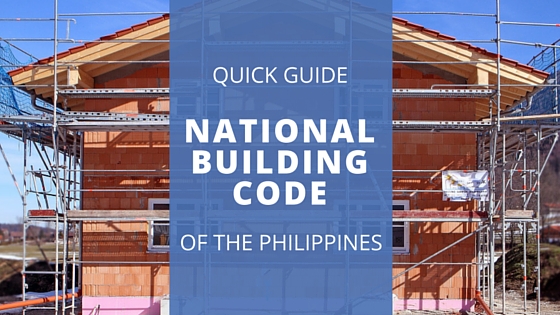
With the first month of 2016 at its prime, it’s also the best time to start planning on home renovations because the demand for real estate won’t be subsiding anytime soon this year. In fact, there will be more people who are going to look for apartments and condos to rent or buy!
If you own an apartment or a condo, then it is definitely the right time for renovations!
With that in mind, always remember to keep track of the costs and the materials needed for such an endeavor. And finally, don’t forget to check the National Building Code regarding renovations and secure the permits that might be needed for the renovations.
That surprised you, right? Unfortunately, there are only few people who know about the National Building Code of the Philippines. For those who are not familiar with it, the National Building Code is a set of rules and regulations pertaining to the construction of all real estate projects and buildings here in the Philippines. In short, if you’re going to build something, you better make sure that the materials and the actual process of constructing the house or building should be in line with all the provisions stated in the National Building Code.
Building Code of the Philippines
And since we’re going to tackle about renovations, here are some information from the National Building Code of the Philippines that will help make the whole renovation process easier:
National Building Code of the Philippines
Section 1.01.03 – Scope of the National Building Code
(a) The provisions of this Code shall apply to the design, location, siting, construction, alteration, repair, conversion, use, occupancy, maintenance, moving, and demolition of, and addition to, public and private buildings and structures.
(b) Additions, alterations, repairs, and changes of use or occupancy in all buildings and structures shall comply with requirements for new buildings and structures except as otherwise herein provided. Only such portion or portions of the existing building or structure which have to be altered to effect the addition, alteration, or repair shall be made to conform to the requirements for new buildings or structures. Alterations should preserve the aesthetic value of the building to be altered.
(c) Where, in any specific case, different section of this Code specify different materials, methods of construction, or other requirements, the most restrictive shall govern.
—–
Talks about what the purpose of the National Building Code is for.
It’s essentially to help anyone in terms of the construction, repair, alteration, occupancy, maintenance and even the demolition of any building in the Philippines, whether it’s private or a government building. Any alterations or modifications done on a building should follow the requirements mandated under the National Building Code for new buildings. Even the materials used for the construction should be in line with the code.
SECTION 1.01.04 – Application for Legitimate Building
(a) This Code shall apply to all buildings and structures constructed and any change or repair made thereon after the approval of said Code. Buildings or structures constructed before the approval of this Code shall not be affected thereby; Except, where their continued use or occupancy is dangerous to life or limb; or where alterations, additions, conversions, or repairs are to be made thereon, this Code shall apply only to such portions of the buildings or structure which have to be altered in order to effect such damages or repairs.
(b) This Code shall apply to chartered cities, poblaciones of municipalities and municipal districts with a population of at least two thousand (2,000) inhabitants, and to barrios of urban areas with a population of at least two thousand (2,000) inhabitants. This Code shall also apply to any area where there are fifty (50) or more families per hectare.
(c) This Code shall likewise apply to any area proposed for or being developed into a new town site, residential subdivision, commercial or residential site, school site, housing project, and similar construction projects where five or more buildings not covered by paragraph (d) of this Section will be constructed even if the poblacion or barrio population is less than two thousand (2,000) or the density of population is less than fifty (50) families per hectare.
—–
If a citizen of the Philippines (or any legitimate company in the Philippines) wishes to construct a building, the National Building Code will be used as basis for the approval of all permits needed for the construction. Lives should not be endangered during the construction of the said building and any alterations or additions to a present establishment should not harm anyone working or living in the said building.
This section also talks about the number of residents living in a city or town for this section of the National Building Code to take effect.
SECTION 1.02.03 – Building permits
(a) Any person, firm, or corporation, including any department, office, bureau, agency of instrumentality of the government intending to construct, alter, repair, move, convert or demolish any building or structure, or cause the same to be done, shall obtain a building permit from the Building Official for whichever of such work is proposed to be undertaken for the building or structure, before any such work is started.
(b) Appropriate rules and regulations shall be set by the Secretary concerning:
(1) Forms for application for building permits;
(2) Procedures to be observed in securing such permits;
(3) Procedures to be observed in the issuance, suspension, and revocation of such building permits; and
(4) Type, nature, and scope of plans and specifications, and other requisite documents, which shall be prepared and designed by a licensed architect or engineer.
SECTION 1.02.04: Fees
(a) Regulations on building permit, inspection and other fees, and for compliance with the same shall be covered by city and municipal ordinances: Provided, That Traditional indigenous family dwellings under Section 1.01.04 (d) shall be exempt from payment of building permit fees.
SECTION 1.02.05: Inspection ad Certificates of Occupancy
(a) Inspection. The duly licensed architect or engineer engaged by the owner to undertake inspection and detailed supervision of the construction shall periodically certify that the construction conforms to the plans and specifications submitted in the application for a building permit. Upon submission of such periodic certifications during the progress of construction, the Building Official shall periodically issue the required authority to continue with the subsequent phases of construction, without prejudice to his right to conduct on his own initiative any inspection of the said construction. Upon completion of the construction, the said duly licensed architect or engineer shall submit to the Building Official the final certification that the building conforms to the provisions of the Code and with the detailed plans and specifications submitted.
—–
This section talks about the manner of inspections done by government officials to deem if the new or renovated building is following the National Building Code.
Only a licensed architect or engineer will be allowed to do the inspection. Of course, the owner can also recommend the architect or engineer and the government will check if this person is qualified for inspecting the new or renovated building. Once the inspection is done, a certification will be released to the owner as proof that the building has been inspected and does follow the requirements as stated in the National Building Code of the Philippines.
(b) Certificates of Occupancy. The proper Certificate of Occupancy shall be issued to the applicant within seven (7) days from completion of the requirements for inspection and occupancy and payment of any and all fees therefor, unless the building Official or his Deputy issuing the Certificate shall show cause in writing why the Certificate should not be issued and shall indicate thereon the particular provisions of the Code violated or the particular requirements not complied with. Within fifteen (15) days from receipt by the applicant of the advice from Building Official or his Deputy authorized to issue the certificate why the certificate should not be issued, or why the certificate is suspended or revoked, the applicant may appeal the non-issuance, suspension, or revocation thereof, to the Mayor of the chartered city or municipality, or the Governor of the province where the building for which the certificate is being applied for is located. Said appeal shall be decided within fifteen (15) days from receipts thereof, otherwise, the applicant may bring the matter to the proper Court of Justice for final disposition. The building may be occupied only upon issuance of the Certificate of Occupancy.
—–
This section also talks about Certificates of Occupancy and how a person can get one. The certificate will be given to any applicant within seven days after the submission of the requirements needed for inspection. Once given, the owner of the said building can now start accepting lodgers for his/her building.
Read this article for a complete summary of the National Building Code.





















